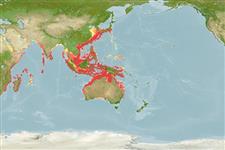Classification / Names
Common names from other countries
Main reference
Size / Weight / Age
Max length : 7.0 cm TL male/unsexed; (Ref. 9835)
Environment
Marine; benthopelagic; depth range 10 - 300 m (Ref. 4066)
Climate / Range
Deep-water, preferred 26°C (Ref. 107945); 37°N - 33°S, 33°E - 154°E
Distribution
Indo-West Pacific: From about 25°S off Mozambique to the Gulf of Oman, east to the Bay of Bengal, Indonesia and western Australia, and north to Japan. Southeast Atlantic: Larvae were present in cruise collections off the eastern coast of South Africa, however, adults have not been reported in this area (Ref. 41388).
Countries | FAO areas | Ecosystems | Occurrences | Introductions
Short description
IUCN Red List Status (Ref. 115185)
Threat to humans
Harmless
Human uses
Fisheries: minor commercial
More information
ReferencesAquacultureAquaculture profileStrainsGeneticsAllele frequenciesHeritabilityDiseasesProcessingMass conversion
Tools
Special reports
Download XML
Internet sources
Estimates of some properties based on models
Phylogenetic diversity index
PD50 = 0.5312 many relatives (e.g. carps) 0.5 - 2.0 few relatives (e.g. lungfishes)
Trophic Level
3.1 ±0.27 se; Based on food items.
Resilience
High, minimum population doubling time less than 15 months (K=1.81)
Vulnerability
Low vulnerability (10 of 100)
Price category
